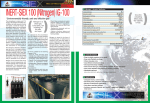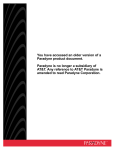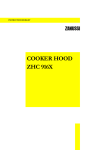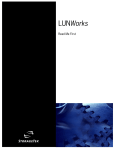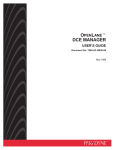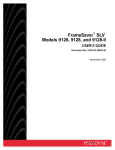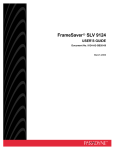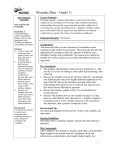Download Paradyne 9161-A2-GN10-40 Network Card User Manual
Transcript
TM 9161 Single T1 Network Access Module (NAM) Installation Instructions Document Number 9161-A2-GN10-40 December 1998 Product Documentation on the World Wide Web We provide complete product documentation online. This lets you search the documentation for specific topics and print only what you need, reducing the waste of surplus printing. It also helps us maintain competitive prices for our products. Complete documentation for this product is available at www.paradyne.com. Select Service & Support → Technical Manuals → T1 Access Multiplexers. Select the following document: 9161-A2-GH30 Model 916x/926x T1 Access Mux Technical Reference To request a paper copy of a Paradyne document: Within the U.S.A., call 1-800-PARADYNE (1-800-727-2396) Outside the U.S.A., call 1-727-530-8623 Before You Begin Make sure you have: An operable T1 network connection An async (VT100-compatible) terminal emulator Housing and other associated hardware Applicable cables Package Checklist Verify that your package contains the following: T1 NAM and associated I/O card Network Interface Cable (14 ft.) V.35 Interconnect Cable (1 ft.) DB9 COM Port Cable (14 ft.) Affidavit Requirements for Connection to Digital Service 1 Safety Instructions Please read the EMI warning and Important Safety Instructions in the Technical Reference or in the installation document that you received with your housing. ! HANDLING PRECAUTIONS FOR STATIC-SENSITIVE DEVICES This product is designed to protect sensitive components from damage due to electrostatic discharge (ESD) during normal operation. When performing installation procedures, however, take proper static control precautions to prevent damage to equipment. If you are not sure of the proper static control precautions, contact your nearest sales or service representative. 496-15149 Available Options The following options are separately orderable: RJ48C modular cable for network access (20 ft.) RJ48H T1 mass termination cable (5 ft.) for connecting seven T1 NAMs to an M66 block What Does a T1 NAM Do? The T1 NAM acts as an interface between the T1 digital network and the customer premises equipment, converting signals received from the DTE to bipolar signals that can be transmitted over T1 and Fractional T1 lines. The T1 NAM also provides a DSX-1 drop and insert port to allow DTEs supporting the DS1 signal format to share the network T1 with other high-speed equipment, as well as two synchronous data ports. Typical applications include: Wide Area Networks (WANs) Channel extension Video teleconferencing 2 Cables You May Need The following cables and connectors are specifically for this product. See Warranty, Sales, and Service Information on page 15 for ordering information. See the Technical Reference for all cable pin-out information. If connecting to a . . . You need a . . . Terminal/printer (DB25 interface/connector – EIA-232 connection) COM Port-to-Terminal/Printer cable (14 ft.) PC (DB9 interface/connector – COM Port-to-PC cable (14 ft.) EIA-232 connection) DTE with a V.35 interface/connector MS34 to DB25 adapter cable for each port: Port 1 and/or Port 2 (1 ft.) DTE with a RS-449 interface/connector DB37 to DB25 DTE adapter cable for each port: Port 1 and/or Port 2 (1 ft.) DTE with a V.11/X.21 interface/connector DB15 to DB25 adapter cable for each port: Port 1 and/or Port 2 (1 ft.) LAN Adapter COM Port-to-LAN Adapter cable (14 ft.) Modem (8-pin modular-to-DB25 connector) Modem cable Recommended Order of Installation 1. First, install the I/O card. 2. Connect all cables into the I/O card. 3. Install the NAM. 4. Go to the appropriate housing installation document for power-up verification procedures: — 2-Slot Housing Installation Instructions (Document No. 9000-A2-GN15) — 5-Slot Housing with AC Power Supply Installation Instructions (Document No. 9000-A2-GN16) — 5-Slot Housing with DC Power Supply Installation Instructions (Document No. 9000-A2-GN1C) — 9000 Series Access Carrier Installation Instructions (Document No. 9000-A2-GN1D) 3 Tools Required A small Phillips screwdriver (#1 or #2) to install the T1 NAM A small, flat-blade screwdriver to install the: — I/O card — Cable connections NAM Rear Panel Installing the I/O Card The NAM’s I/O card provides the COM port, network, DSX and DTE connections. The I/O card inserts directly behind the NAM that it supports. Slot numbers are identical (in this case, Slot 01) to facilitate correct installation. SI T1NGL NA E M N ET 1. Remove the I/O card from the shipping box. Handle only by the top and bottom edges to avoid damaging the card. 2. At the rear of the housing, align the I/O card with the upper and lower tracks of the slot. Push gently towards the midplane until it stops and you cannot push the card any further. Access Carrier 5-Slot 2-Slot NET DBM DB M (For Future Use) DSX DS X Port 1 PO RT 1 Port 2 Screws PO RT Screws Screws Rear View 3. There are two captive screws on the I/O card. Using a screwdriver, alternately tighten each screw until the screws are all the way in. 4 97-15748a CO M 2 COM 98-15050-03 Connecting to the Network 1. Insert the 8-pin connector on the RJ48C network cable into the NET interface. SI T1NGL NA E M NE T RJ48C Jack 2. Insert the other end of the cable into the RJ48C modular jack. NET DB M DS X 98-15053-02 Connecting to a DTE If the DTE cable type is V.35, RS449, or V.11/X.21 (separately orderable): 1. Connect the plug to the V.35, RS449, or V.11/X.21 end of the adapter cable (as appropriate). SI T1NGL NA E M NE T DTE 2. Connect the EIA 530A end of the adapter cable to PORT 1 or PORT 2. If the DTE cable type is EIA-530A: 1. Connect the EIA-530A end of the DTE cable to PORT 1 or PORT 2. DB M V.35, RS-449, V.11/X.21 Adapter Cable DTE Cable DS X Port 1 PO RT 1 DTE Port 2 PO RT DTE Cable 2 CO M 98-15054-02 5 Connecting to the DSX SI T1NGL NA E M 1. Insert the DB15 end of the DSX cable into the DSX interface. 2. Insert the other end of the cable into the CPE (Customer Premises Equipment, such as a PBX). NE T DB M DSX PBX DS X PO RT 1 98-15055-02 Connecting the COM Port to a User Interface 1. Insert the 8-pin end of the cable into the COM port. 2. Insert the other end of the cable into the user interface (VT100-compatible terminal emulation) connector. 3. Press Return on the keyboard to display the Main Menu. If you need to configure for other than a direct link, see the Technical Reference. COM Port-to-Terminal/Printer Cable or COM Port-to-PC Cable COM PO RT * 2 CO M 496-15052-01 * Set the speed of the async (VT100-compatible) terminal so it matches the NAM's factory-loaded data rate of 19.2 kbps, character length set to 8, parity set to None, and stop bits set to 1. The flow control should be set to None or Hardware. 6 Installing the T1 NAM In both the 2- and the 5-slot housings, the NAM is always installed in Slot 01. The NAM can be installed in any slot in the access carrier. ! WARNING: Do NOT remove any jumpers located on the battery. To do so can cause non-volatile memory loss. Should a jumper become separated from the battery, contact your service representative immediately. CAUTION: Be sure that you install the NAM in the correct slot so that it mates with its matching I/O card. Otherwise, you could damage your card. 1. Remove the housing’s bezel, if applicable. See the housing installation instructions for information. 2. Remove the NAM from the shipping box. Handle only by the top and bottom edges to avoid damaging the card. 3. At the front of the housing, align the NAM with the upper and lower tracks of the appropriate slot. 2-Slot Ejector Latches 5-Slot Access Carrier Ejector Latches Ejector Latches Front View 98-15750-01 4. Slide into the tracks until the NAM seats with the midplane connectors. Be careful not to force the card or bend any pins. 5. Close both the upper and lower ejector latches on the housing to lock in place, then tighten the captive screws on the ejector latches. 6. Replace the housing’s bezel, if applicable. 7 Removing/Replacing a Card Card removal procedures differ, depending on whether you are removing the card from the front or rear of the housing. If you are removing the . . . Then go to . . . NAM Removing/Replacing the NAM. I/O card Removing/Replacing the I/O Card. Removing/Replacing the NAM 1. Remove the housing’s bezel, if applicable. See the housing installation instructions for information. 2. Remove the captive screws from the ejector latches on front of the housing. 3. Press open the ejector latches to disengage the card. 4. Supporting the card by its edges, pull straight out until the card clears the housing. 5. Align the replacement card with the upper and lower tracks of the slot. Slide forward until the NAM seats. Be careful not to force or bend any pins. 6. Close both the upper and lower ejector latches on the housing to lock in place, then tighten the captive screws. 7. Replace the housing’s bezel, if applicable. Removing/Replacing the I/O Card 1. Remove the NAM from the housing (see Removing/Replacing the NAM ). 2. Remove the network, DSX-1, DTE, and COM port cables from the I/O card (if applicable). 3. Using a screwdriver, loosen the upper and lower screws fastening the card to the housing’s frame. 4. Gently pull the I/O card away from the midplane until it clears the housing. 5. Align the replacement I/O card with the upper and lower tracks of the slot. Push gently towards the midplane until it stops and you cannot push the card any further. 6. Alternately tighten each captive screw until the screws are all the way in. 7. Reattach the cables as appropriate. 8. Reinstall the NAM. Power-Up Go to your housing instructions to perform power-up, if needed. The housing instructions also contain troubleshooting information. 8 Front Panel LEDs and Test Jacks The T1 NAM has 12 LED (light-emitting diode) status indicators and four sets of test jacks. Test Jacks The NAM contains four sets of test jacks. Use these for: IN NET OU T Monitoring and testing towards the Network 1 interface carrier Monitoring and testing towards the Network 2 interface carrier IN DSX OU T Test Jacks IN NET MON Refer to Troubleshooting and Maintenance in the Technical Reference for more information on the test jacks. OU T IN DSX MON General Status LEDs OU T 9161 OK Label Indication AL OK M TS T BK P Color Power and Green Operational Status SIG NETWORK AL M LEDs SIG DSX OO F CYCLING – The unit is in Minimum mode. Requires an FTP download. AL M 1– PORT 2– ON – NAM has power and is operational. OFF – NAM is in a power-up self-test, or there is a failure. OO F What It Means OK OK ALM 496-15051 System Failure/ Self-Test Red ON – NAM has just been reset, or an error or fault has been detected. OFF – No failures have been detected. TST Test Mode Yellow ON – Loopback or test pattern in progress, initiated locally, remotely, or from the network. OFF – No tests are active. BKP Backup 9 Yellow Not supported. Remains off except during a Lamp Test. Network and DSX Interface LEDs Label Indication Color What It Means SIG Signal Green ON – A recoverable signal is present on the network/DSX interface. OFF – The signal cannot be recovered from the network/DSX interface. An LOS condition exists. OOF Out of Frame Yellow ON – At least one OOF was detected during the sampling period. OFF – No OOFs were detected during the sampling period. ALM Alarm Yellow ON – An alarm condition is present on the network/DSX interface. Current alarm conditions: Loss of Signal ( LOS ) Loss of Frame (LOF) Excessive Error Rate (EER) Yellow Alarm Alarm Indication Signal (AIS) OFF – No alarm condition is present on the network/DSX interface. Port 1 and Port 2 LEDs Label Indication Color What It Means 1-OK 2-OK Operational Status Green ON – The interchange circuits for the port are in the correct state to transmit and receive data. OFF – The port is idle. Occurs if the port is disabled, if an EDL Out of Frame or EER condition is present, if a DCLB is active, or if the port is configured to monitor DTR and/or RTS and the lead(s) is not asserted. 10 Troubleshooting Symptom Possible Cause Solutions No power, or none of the system LEDs are lit. For DC power source, DC power is not present. Check the DC power source. For AC power source, the wall receptacle has no power, or the housing’s power cord is not securely plugged into the wall receptacle or the back of tthe e housing. ous g 1. Check the wall receptacle power by plugging in some equipment that is known to be working. 2. Check that the power cord is securely attached at both ends. 3. Check the circuit breaker. Power-Up Self-Test fails. Only Alarm LED is on after power-up. LED is burned out. Run the Lamp Test. If the LED in question does not flash with the other LEDs, then contact your service representative. The NAM has detected an internal hardware failure. 1. Reset the NAM and try again (see the Technical Reference). 2. Contact your service representative. Cannot access the NAM or the user interface. Login or password is incorrect, COM port is misconfigured, or the NAM otherwise configured so it prevents access. 1. Reset the NAM (see the Technical Reference). Device Fail appears on the System Health and Status screen. The NAM detects an internal hardware failure. Record the 8-digit code from the System Health and Status screen, then contact your service representative. Not receiving data at DTE or DSX-1 interface. Not cross-connected to the correct timeslot(s). Verify cross connections using the Cross Connect configuration option. 11 2. Contact your service representative. Technical Specifications Specification Criteria Weight T1 NAM T1 I/O card 1 lb. 2 oz. (.51 kg) 6 oz. (.17 kg) Size T1 NAM T1 I/O card 11.58″ x 8.00″ (29.41 cm x 20.32 cm) 2.90″ x 10.15″ (7.37 cm x 25.78 cm) Power Consumption 9.4 watts, 0.78 amps input current at 12 volts Physical Environment Operating temperature 35° F to 122° F ( 1.7° C to 50° C ) Storage temperature –4° F to 158° F (– 20° C to 70° C ) Relative humidity 5% to 85% ( noncondensing ) Shock and vibration Withstands normal shipping and handling Network T1 Interface Physical Interface (USA) Physical Interface (Canada) Framing Format Coding Format Line Build-Out (LBO) ANSI PRM Bit Stuffing Yellow Alarm Generation RJ48C CA81A using adapter cable D4, ESF AMI, B8ZS 0.0 dB, –7.5 dB, –15 dB, –22.5 dB Selectable FCC Part 68, AT&T TR 62411 Selectable DSX-1 Interface Physical Interface Framing Format Coding Format DTE Line Equalization Send AIS DB15 socket D4, ESF AMI, B8ZS 5 selectable ranges from 0 to 655 feet (0 to 196.5 meters) Selectable DTE Ports/Interfaces Standards Rates EIA-530A, V.35, RS-449, V.11, X.21 Nx64 – 64K to 1.536 Mb Nx56 – 56K to 1.344 Mb COM Port/Interface Data Rates 9.6, 14.4, 19.2, 28.8, 38.4 , 57.6, 115.2 kbps 57.6, 115.2 kbps are recommended for FTP download only 12 Specification Criteria DBM (Backup) connector (reserved for future use) One 8-position modular keyed USOC RJ45 jack Clocking Sources T1 network interface, any port, internal clock, DSX-1 T1 interface or external clock Loopbacks Standard Additional Network Line Loopback, Network Payload Loopback, V.54 Loop 2 (DCLB) and V.54 Loop 3 (DTPLB) Network Repeater Loopback, DSX-1 Line Loopback DSX-1 Payload Loopback, DSX-1 Repeater Loopback, DTE Loopback Pin Assignments NET Port/Interface Function Circuit Pin # Receive ring from the network R1 1 Receive tip from the network T1 2 Transmit ring to the network R 4 Transmit tip to the network T 5 Signal Direction Pin # DCE Transmit Clock ( TXC ) Out 1 DCE Receive Data ( RXD ) Out 2 Signal Ground ( SG ) — 3 DCE Transmit Data ( TXD ) In 4 DCE Data Terminal Ready ( DTR ) In 5 DCE Carrier Detect ( CD ) Out 6 DCE Request to Send ( RTS ) In 7 DCE Receive Clock ( RXC ) Out 8 COM Port/Interface 13 DSX Port/Interface Function Circuit Pin # Receive tip from the DTE T1 1 Receive ring from the DTE R1 9 Transmit tip to the DTE T 3 Transmit ring to the DTE R 11 Shield – 2,4 DTE Ports/Interfaces Signal Circuit ITU/ Mnemonic CCITT # Direction 25-Pin Pin # Shield — — — 1 Transmitted Data ( TXD ) BA 103 To DCE 2 (A) 14 (B) Received Data ( RXD ) BB 104 From DCE 3 (A) 16 (B) Request to Send ( RTS ) CA 105 To DCE 4 (A) 19 (B) Clear to Send ( CTS ) CB 106 From DCE 5 (A) 13 (B) Data Set (or DCE ) Ready ( DSR ) CC 107 From DCE 6 Signal Ground/Common ( SG ) AB 102A — 7 Received Line Signal Detector CF ( RLSD or LSD ) 109 From DCE 8 (A) 10 (B) Transmit Signal Element Timing (TXC – DTE Source) DA 113 To DCE 11 (B) 24 (A) Transmitter Signal Element Timing ( TXC – DCE Source) DB 114 From DCE 12 (B) 15 (A) Receiver Signal Element Timing ( RXC – DCE Source ) DD 115 From DCE 17 (A) 9 (B) Local Loopback ( LL ) LL 141 To DCE 18 Data Terminal (or DTE ) Ready ( DTR ) CD 108/1, /2 To DCE 20 Remote Loopback ( RL ) RL 140 To DCE 21 Signal Common AC 102B — 22, 23 Test Mode Indicator ( TM ) TM 142 From DCE 25 14 Warranty, Sales, and Service Information Contact your local sales representative, service representative, or distributor directly for any help needed. For additional information concerning warranty, sales, service, repair, installation, documentation, training, distributor locations, or Paradyne worldwide office locations, use one of the following methods: H Via the Internet: Visit the Paradyne World Wide Web site at http://www.paradyne.com H Via Telephone: Call our automated call system to receive current information via fax or to speak with a company representative. — Within the U.S.A., call 1-800-870-2221 — Outside the U.S.A., call 1-727-530-2340 Document Feedback We welcome your comments and suggestions about this document. Please mail them to Technical Publications, Paradyne Corporation, 8545 126th Ave. N., Largo, FL 33773, or send e-mail to [email protected]. Include the number and title of this document in your correspondence. Please include your name and phone number if you are willing to provide additional clarification. Trademarks All products and services mentioned herein are the trademarks, service marks, registered trademarks or registered service marks of their respective owners. Copyright E 1998 Paradyne Corporation 15
















